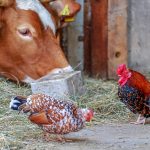The color of dark meat in chicken [or indeed poultry in general,] such as that found in the legs and thighs, is influenced by several factors, including the type of muscle fibers, the presence of myoglobin, and the chicken’s diet and genetics.
The key factors that contribute to the color of dark chicken meat are many and varied.
1. Muscle Fiber Type
The color of meat is largely determined by the type of muscle fibers present in the meat. Dark meat is primarily composed of slow-twitch muscle fibers, also known as Type I fibers. These fibers are rich in myoglobin, a protein responsible for storing oxygen in muscle cells. Myoglobin gives dark meat its characteristic deep reddish-brown color.
2. Myoglobin Content
As mentioned earlier, myoglobin is a protein that stores oxygen in muscle cells. The higher the myoglobin content, the darker the meat color. Dark meat has a higher concentration of myoglobin compared to white meat, which is found in the breast and wings of the chicken.
3. Blood Supply
Dark meat areas of the chicken, such as the legs and thighs, have a richer blood supply compared to white meat. This increased blood supply delivers more oxygen to the muscle cells, which enhances the myoglobin content and contributes to the darker color.
4. Chicken’s Diet
The diet of the chicken can impact the color of its meat. Specifically, the amount and type of pigments in the diet can influence the intensity of the meat’s color. For example, chickens that are fed diets high in pigments like carotenoids (found in certain plants and grains) may produce meat with a slightly deeper color.
5. Genetics
The genetics of the chicken breed also play a role in determining the color of its meat. Different breeds have varying levels of myoglobin and pigments, which can lead to variations in color. Breeds that are naturally more active and have a higher proportion of slow-twitch muscle fibers will typically have darker meat.
6. Age of the Chicken
The age of the chicken can affect the color of its meat as well. Younger chickens tend to have meat that is lighter in color compared to older chickens. As chickens age, their muscles become more developed and contain higher amounts of myoglobin, leading to a deeper color.
7. Cooking Method
The color of dark meat can also be influenced by the cooking method used. For example, when dark meat is cooked to a higher temperature, the myoglobin proteins can denature and release their pigments, causing the meat to appear darker after cooking.
In summary, the color of dark meat in chicken is influenced by a combination of factors including muscle fiber type, myoglobin content, blood supply, diet, genetics, age of the chicken, and cooking method. These factors interact to create the distinctive deep reddish-brown color that characterizes dark meat in chicken.

I often wondered about all that strange dark meat in my roast chicken and now I see where it comes from. Weird!